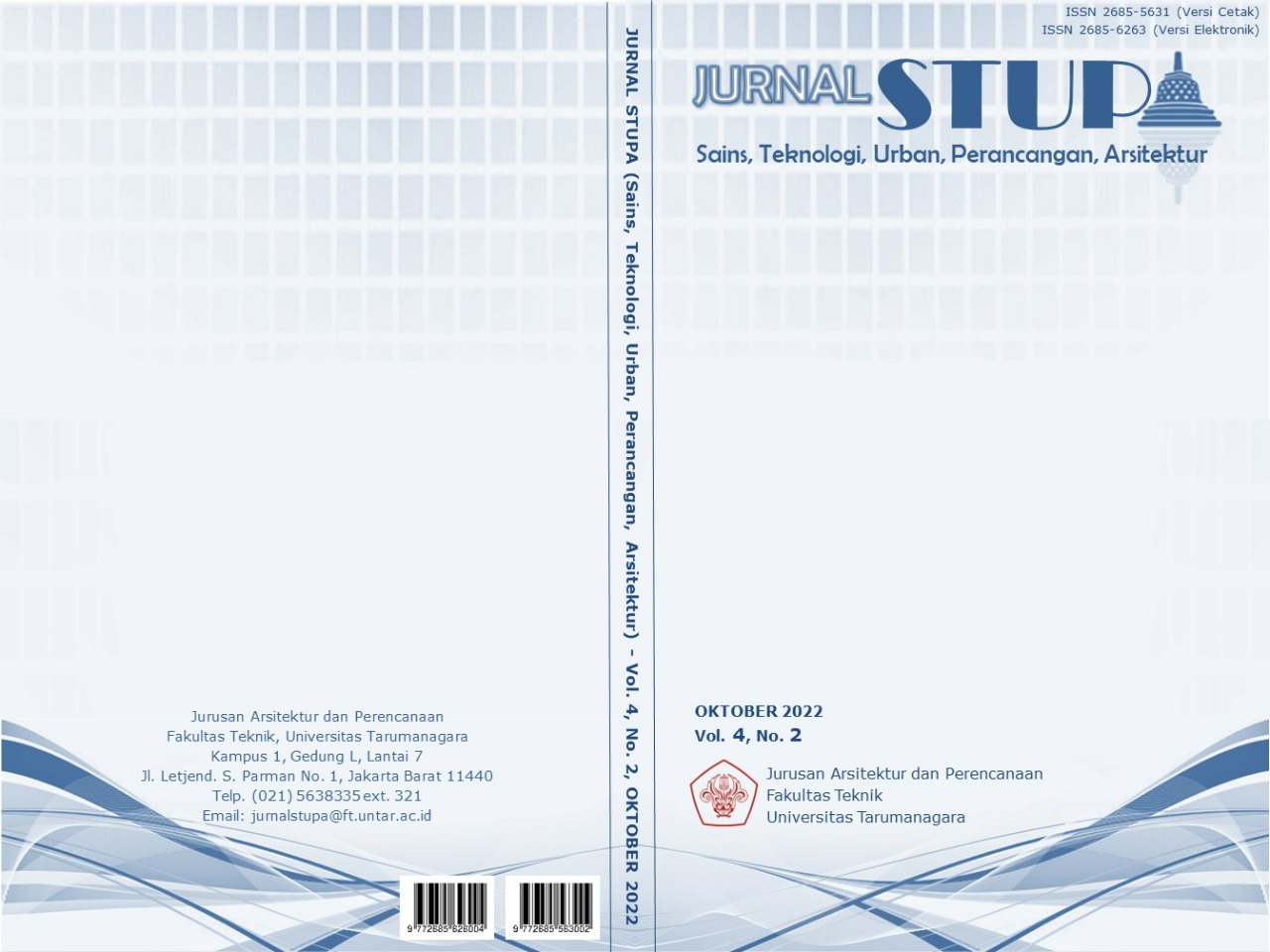PENERAPAN VOID PEDAGOGY PADA PERANCANGAN RUANG KOMUNITAS DAN FASILITAS PELATIHAN LITERASI DIGITAL DI RAWA SIMPRUG, JAKARTA SELATAN
Main Article Content
Abstract
According to the UNHCR, adequate housing must have access to certain public facilities, infrastructure, and utilities, such as educational, health, recreational facilities. However, these facilities are difficult to find in kampung such as Rawa Simprug. The current existing public facilities have been degraded and are no longer suitable for use. Thus, there is very minimal room for active social interaction. In addition to that, as the world is re-entering a post-pandemic era, the application of technology in people’s everyday lives is indispensable. For instance, traditional markets are now equipped with low-technology to help the process of digitalized transaction. Therefore, the need for digital literacy is increasing in order to help society ease into this new era. The Community Hub and Digital Literacy Training Facility is a recreational, social, and educational facility in Rawa Simprug, South Jakarta. Lending the theory of void pedagogy from Charlie Edmonds, the urban void in Rawa Simprug can be refunctioned to reactivate the space. Through the reactivation of void spaces, the urban pedagogy explores the relationship between spatial freedom and progressive education, especially for digital literacy training. The design approach is layered architecture, adapted from software architecture to solve the design problems. This project aims to provide a space for social interaction and a digital literacy training facility through the integration of nature and technology as a strategy for urban acupuncture
Keywords: Digital Literacy; Interaction; Rawa Simprug; Urban Acupuncture; Urban Void
Abstrak
Menurut UNHCR, perumahan yang layak huni harus dilengkapi dengan sarana, prasarana, dan utilitas umum seperti fasilitas pendidikan, kesehatan, dan rekreasi. Namun, hal ini sulit ditemukan di perkampungan seperti kawasan Rawa Simprug. Fasilitas umum yang ada mengalami degradasi fisik dan sudah tidak layak untuk digunakan, sehingga interaksi aktif antar masyarakat semakin berkurang. Selain itu, saat ini masyarakat sudah memasuki era pasca-pandemi – penggunaan teknologi dalam kehidupan sehari-hari sangat diperlukan. Contoh yang sudah ada adalah pasar yang dilengkapi low-tech. Hal ini dapat memudahkan transaksi dari yang sebelumnya konvensional menjadi lebih modern. Oleh sebab itu, literasi digital semakin dibutuhkan agar dapat membantu keseharian masyarakat di era baru ini. Ruang Komunitas dan Fasilitas Pelatihan Literasi Digital merupakan fasilitas rekreasi, sosial, dan edukasi di Rawa Simprug, Jakarta Selatan. Meminjam teori void pedagogy Charlie Edmonds, urban void di Rawa Simprug dapat diolah kembali agar menjadi ruang-ruang yang lebih aktif. Melalui reaktivasi void spaces di kawasan Rawa Simprug, konsep urban pedagogy ini menelusuri hubungan antara kebebasan spatial dengan edukasi progresif, khususnya untuk pelatihan literasi digital. Pendekatan perancangan arsitektur merupakan layered architecture yang diadaptasi dari software architecture untuk mengatasi masalah perancangan. Proyek ini bertujuan untuk menghadirkan ruang interaksi sosial masyarakat, sekaligus fasilitas pelatihan literasi digital melalui integrasi alam dan teknologI sebagai strategi urban acupuncture.
Article Details

This work is licensed under a Creative Commons Attribution-NonCommercial-ShareAlike 4.0 International License.
This work is licensed under a Jurnal Sains, Teknologi, Urban, Perancangan, Arsitektur/ STUPA Creative Commons Attribution-NonCommercial-ShareAlike 4.0 International LicenseReferences
Azzahra, N., & Amanta, F. (2021). Promoting Digital Literacy Skill for Students through Improved School Curriculum. Jakarta: Center for Indonesian Policy Studies (CIPS).
Casagrande, M. (1986, September). From Urban Acupuncture to the Third Generation City. Journal of Biourbanism.
Dobson, S. (2006, Juli). Urban pedagogy: a proposal for the twenty‐first century. London Review of Education, 4(2).
Edmonds, C. (2021). Master's Thesis - University of Cambridge. Retrieved Maret 2022, from The Dots: https://the-dots.com/projects/master-s-thesis-university-of-cambridge-401750
Edmonds, C. (2021). Void Pedagogy explores the potential for progressive pedagogies to be facilitated by a distributed school in Tokyo. Retrieved Maret 2022, from Future Architecture: https://futurearchitectureplatform.org/projects/be4ac93a-f1e5-4b38-871e-2bcd6b6afe2d/
Gerbaudo, P. (2016). From Data Analytics to Data Hermeneutics Online Political Discussions, Digital Methods and the Continuing Relevance of Interpretive Approaches. Digital Culture & Society.
Gillen, N., Nissen, P., Park, J., Scott, A., Singha, S., Taylor, H., . . . Featherstone, S. (2021). RETHINK Design Guide: Architecture for a post-pandemic world. London: RIBA Publishing.
Hargittai, E., & Hinnant, A. (n.d.). Digital Inequality Differences in Young Adults' Use of the Internet. Communications Research, 35(5).
Hendriyani, I. D. (2022, April 21). Siaran Pers: Menparekraf Dorong Komunitas Maksimalkan Rumah Kreatif Melati Babel Sebagai Etalase Produk Kreatif. Retrieved from Kementrian Pariwisata dan Ekonomi Kreatif: https://kemenparekraf.go.id/berita/siaran-pers-menparekraf-dorong-komunitas-maksimalkan-rumah-kreatif-melati-babel-sebagai-etalase-produk-kreatif
Kushwah, N., & Rathi, K. (2017). Urban Voids - Reclaiming Urban Space. International Journal of Advance Research, Ideas and Innovations in Technology., 3(1), 197-198.
Lerner, J. (2014). Urban Acupuncture. Island Press.
Lopez-Pineiro, S. (2020). A Glossary of Urban Voids. JOVIS.
Mason, H. (2022, Mei). Making strides to make digital literacy facilities accessible to children across Sierra Leone. Retrieved 2022, from UNICEF Sierra Leone: https://www.unicef.org/sierraleone/stories/making-strides-make-digital-literacy-facilities-accessible-children-across-sierra-leone
The Right to Adequate Housing Fact Sheet No. 21. (n.d.). Retrieved 2022, from https://www.ohchr.org/sites/default/files/Documents/Publications/FS21_rev_1_Housing_en.pdf
Trancik, R. (1986). Finding Lost Space: Theories of Urban Design. Van Nostrand Reinhold Company.
Yamasaki, Y. (2017). Kinokuni Children's Village School. In Y. Yamasaki, & H. Kuno, Educational Progressivism, Cultural Encounters and Reform in Japan (Vol. 1). Routledge.



